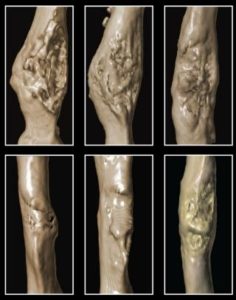 The team, from Stanford University School of Medicine in Palo Alto, CA, reports the findings in the journal Science Translational Medicine.
The team, from Stanford University School of Medicine in Palo Alto, CA, reports the findings in the journal Science Translational Medicine.
Michael T. Longaker, a professor of plastic and reconstructive surgery and one of the study’s senior authors, sums up the work:
“We’ve uncovered the reason why some patients with diabetes don’t heal well from fractures, and we’ve come up with a solution that can be locally applied during surgery to repair the break.”
Diabetes is a chronic disease that occurs when the body’s ability to produce or respond to insulin – a hormone that regulates blood sugar – is impaired.
Raised blood sugar (hyperglycemia) is a common effect of uncontrolled diabetes, and over time it can cause serious damage in many parts of the body, including the heart, blood vessels, eyes, kidneys, and nerves.
Today, there are more than 420 million people with diabetes worldwide – nearly four times as many as there were in 1980 (108 million).
Problematic bone healing is one of the many health complications that people with diabetes experience; following a break or fracture, their bones may heal poorly.
“Diabetes is rampant worldwide,” says Prof. Longaker, “and any improvement in the ability of affected people to heal from fractures could have an enormously positive effect on their quality of life.”
Reduction in skeletal stem cell activity in diabetic mice
In their study, Prof. Longaker and colleagues observed a reduction in bone stem cell activity in mice bred to develop diabetes, as well as in bone samples from diabetic patients who had undergone joint replacements.
Fast facts about diabetes
Estimates suggest that around 8.5 percent of adults have diabetes
The disease is a major cause of kidney failure, blindness, heart attacks, stroke, and lower limb amputation
Rates of diabetes have been rising faster in middle- and low-income countries.
Learn more about diabetes
In further experiments, they discovered a protein that stimulates the bone stem cells. When they applied the protein to bone fracture sites in the mice, it increased expression of key signaling proteins and enhanced healing in the animals.
The new study builds on previous work some of the team had contributed to, which identified and described a population of cells in the bones of mice that function as skeletal stem cells (SSCs).
These adult stem cells have the potential to become components of the skeletal system, including bone, cartilage, and stroma – a part of the bone marrow.
The researchers went on to discover that fracture healing in mice was severely impaired when their SSCs levels were very low.
This finding got the team wondering whether there could be a problem with SSCs in people with diabetes, whose bones often heal poorly following fractures.
Diabetic mice had fewer ‘hedgehog’ signaling proteins
For the new study, the team used mice bred to develop type 2 diabetes when they reached approximately 4 weeks of age. The animals showed normal fracture healing before the disease developed. However, after onset, repaired bone was significantly weaker and less dense than bone in normal, non-diabetic mice.
The team also discovered that diabetic mice had much lower numbers of SSCs in healing bones 7 days after fracture than normal mice.
After a series of experiments, the researchers established that the SSCs themselves were working normally, and that there were no systemic reasons for the reduction in numbers.
This left the possibility of a problem with the signals the cells receive from their environment, or niche.
When the researchers took a closer look, they found that the diabetic mice produced fewer “hedgehog” signaling proteins, which are known to be important for embryonic development, tissue regeneration, and other key biological processes.
They went on to show that blocking the hedgehog signaling pathway in non-diabetic mice with fractures caused regrowth of bone that was weaker and more brittle than normal – just like their diabetic counterparts.
Increases in TNF-alpha blocked hedgehog signaling
The team also found that adding the hedgehog signaling proteins back into the SSC niches of the diabetic mice restored their ability to heal fractures like normal mice.
In a final set of experiments, the team worked with bone samples from patients with and without diabetes who had undergone joint replacements for osteoarthritis.
The researchers compared the expression of proteins important to the hedgehog signaling pathway in the samples. What they found was similar to the results they saw in the mice. The bone samples from diabetic patients showed significantly reduced expression of the signaling proteins.
They wondered if the reduced signaling was due to the effect that diabetes-associated inflammation has on tumor necrosis factor alpha (TNF-alpha) – levels of which are known to be raised in people with diabetes.
The team found corresponding increases in TNF-alpha in the diabetic mice. Further tests showed these raised levels of the molecule blocked expression of some hedgehog signaling proteins.
However, the researchers warn that completely blocking all TNF-alpha could result in serious consequences, as the molecule plays a key role in so many other biological processes.
MNT DT






